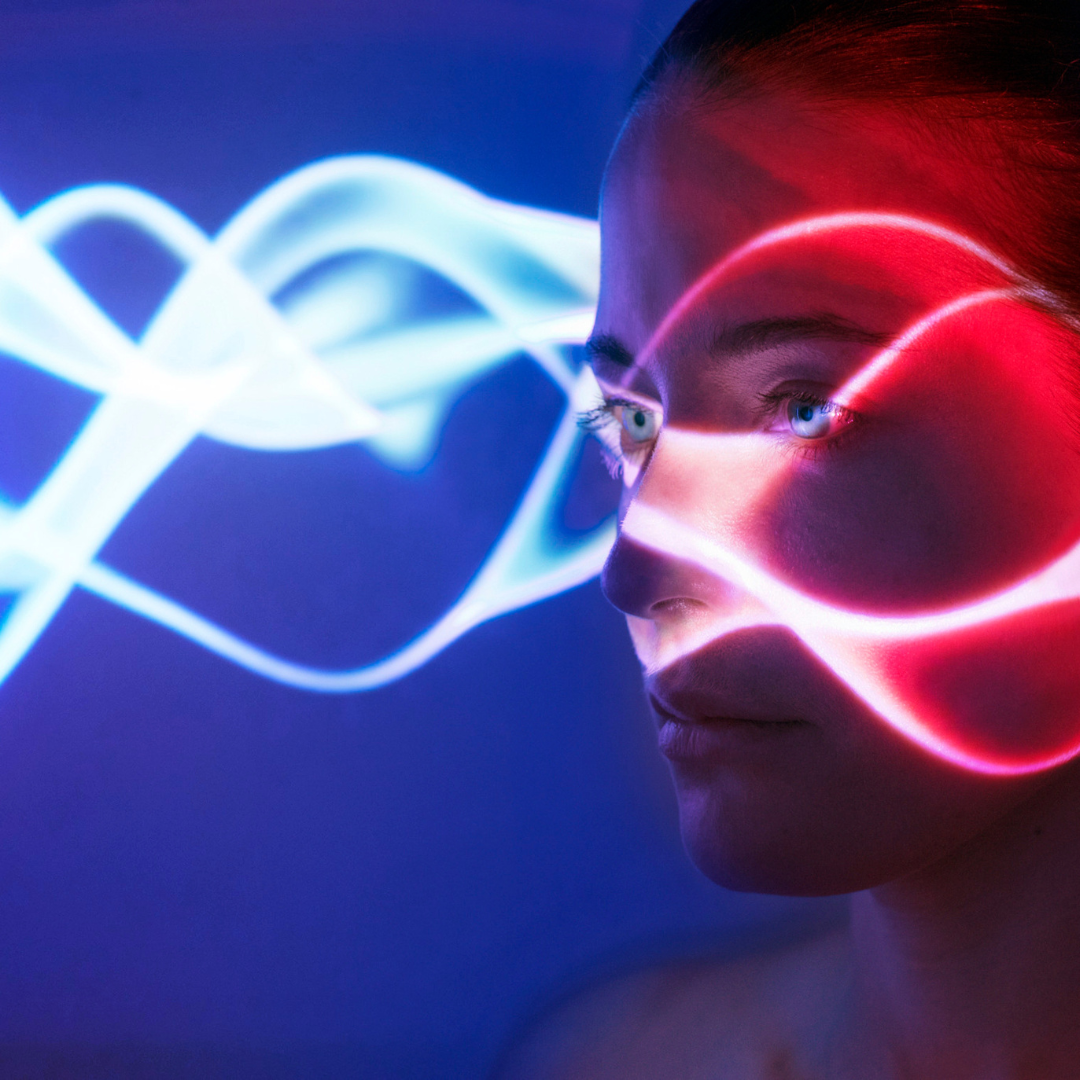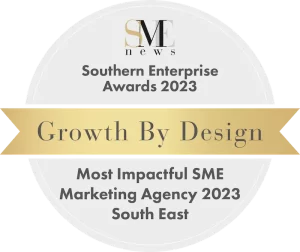In today’s fast-paced world, where consumers are bombarded with commercial messages daily, standing out as a business can be challenging.
Marketers can use many different ways to do this, but the one we want to explore today is about creating a multisensory experience.
What we mean by this is typically using images and words to affect other senses, conjure up smells, sensations, sensory memories etc in your prospect. For example, the smell of chocolate from an image, or if you think about how wine is often described as having tones, colours, fragrances etc.
All of these use what is referred to as multisensory marketing or, if you want to be really fancy: linguistic synaesthesia to create a memorable message.
In short, this strategy engages multiple senses to evoke emotions and leave a lasting impression on the audience.
At Growth by Design, we firmly believe this type of multisensory marketing can be used in both print and digital marketing by SMEs. So let’s explore how this approach can elevate your marketing efforts and connect with your audience on a deeper level.
The multisensory revolution
You might have experienced this during Christmas shopping, with stores combining ambient Christmas music and scents to create a festive atmosphere and increase sales.
Video advertisements also rely on multisensory strategies. Take McDonald’s ads, for instance, where the iconic red and yellow logo triggers visual associations, while the familiar jingle triggers auditory associations with the brand.
While global brands like McDonald’s have established strong associations, multisensory marketing is equally relevant for local SME businesses. By tapping into local brand awareness and associations, SMEs can create powerful connections with their target audience.

Examples of multisensory marketing for SMEs
Pop-up Stores
Retailers can create temporary pop-up stores that showcase products visually and incorporate soundscapes, scents, and tactile elements. This multisensory approach enhances the shopping experience and makes it more enjoyable for customers.
Virtual reality (VR) experiences
You could use VR technology to offer immersive experiences beyond sight and sound. VR can simulate touch and movement, making consumers feel physically present in a different environment or interacting with products.
If you are local to Brighton, there is the Van Gogh Alive exhibition at the Brighton Dome, which is a really nice example of how VR can work and the level of engagement that is possible from it.
Sensory packaging
You could focus on the sensory aspects of packaging, such as the texture, the sound of unwrapping, and even the product’s scent. This creates a more enticing and memorable unboxing experience for customers. Unboxing is a big YouTube trend, so if you have physical products, it is something worth considering.
Interactive advertising
Digital advertising campaigns are designed to be interactive and engage multiple senses. For example, interactive ads may allow users to touch, swipe, or rotate product images, enhancing engagement and memorability.
Scent marketing
Retail stores and hospitality businesses can use scents strategically to create a specific ambience and emotional connection. The right scent can evoke positive emotions, such as relaxation or excitement, and influence purchasing decisions.
Beauty brands know all about this, but it doesn’t have only to be this sector that uses it; for example if you are a carpenter or use wood in your products, the scent from that could be used.
Tasting events
If you are a food and beverage company, hosting tasting events to allow customers to experience your products firsthand could be a key element of your marketing strategy. These events engage taste and smell senses, creating a more immersive and enjoyable experience.
Sound branding
Brands develop unique sound logos or jingles that customers can associate with their products or services. These sonic cues reinforce brand identity and trigger brand recognition when heard. Local radio advertisers use these a lot, and if you’ve ever undertaken any advertising in that way, you could reflect on how to repurpose that jingle into your other marketing.
Haptic feedback
Excuse the jargon for a second, but when it comes to marketing to mobile devices, it could incorporate haptic feedback, providing subtle vibrations or tactile sensations when users interact with certain elements.
This enhances user experience and creates a more engaging interaction with apps and websites.
Visual communication
Visual communication is crucial in multisensory marketing, enabling advertisers to establish creative associations between words and images.
By effectively combining language and images, ads can evoke multiple sensory domains and leave a lasting impact on the audience.
Visual communication in multisensory marketing refers to using visual elements, such as images, graphics, colours, and videos, to convey messages and evoke emotions in the audience.
In multisensory marketing, visual communication complements other sensory experiences, like sound, touch, taste, and smell, to create a more engaging and memorable marketing experience.
Simply put, visual communication in multisensory marketing harnesses the power of sight to enhance the overall impact of a marketing campaign and bring your prospects’ other senses into play.
It leverages visuals to stimulate emotions, trigger associations, and establish creative connections between sensory domains.
Tasting events, scents, jingles, and VR may not be appropriate for your SME business. Still, nothing is stopping any business from cleverly using images to evoke emotions and the other senses.
Examples of visual communication in multisensory marketing
Here are some examples we’ve come up with to give you some inspiration and prove multisensory marketing is very much for small and medium-sized businesses as much as it is for large corporates:
- An advertisement for perfume uses an image of flowers and vibrant colours to evoke a sense of fragrance and luxury.
- A video ad for a food product featuring close-up shots of delicious and visually appealing dishes to trigger the audience’s taste sensations.
- The use of bright and bold visuals in a poster for a music concert to create excitement and anticipation for the event.
- Incorporating images of happy customers enjoying a product in social media posts to evoke positive emotions and encourage others to try the product.
- Using visually appealing graphics and illustrations in a website design to enhance user experience and engagement.
- Displaying enticing product images on an e-commerce website to encourage customers to make a purchase.
- Incorporating visually striking infographics in a blog post to convey complex information in an easy-to-understand and visually appealing manner.
Why does all of this matter? Fundamentally, visual communication is a powerful tool in multisensory marketing because it captures the audience’s attention and leaves a lasting impression.
When combined with other sensory experiences, such as sound or touch, it can create a more immersive and memorable marketing experience, increasing the chances of building strong brand associations, differentiation, customer engagement and, ultimately, sales.
Multisensory marketing goes beyond traditional advertising by tapping into the human senses to create a deeper and more meaningful connection between brands and consumers.
By leveraging the power of multiple senses, companies can differentiate themselves and build stronger brand loyalty and recognition.
Linguistic synaesthesia
One powerful method used in multisensory print ads is linguistic synaesthesia, which combines language that refers to different senses.
It is a creative language technique used in marketing to evoke multiple senses in the audience’s mind by combining words or expressions that refer to different senses. It creates powerful associations that make the message more memorable and impactful.
Examples of linguistic synaesthesia in marketing
“Sweet Melody”
This phrase combines the sense of taste (sweet) with the sense of hearing (melody) to describe a delightful experience, such as a tasty dessert or a soothing musical piece.
“Velvety Voice”
Here, the word “velvety” evokes the sense of touch, while “voice” relates to hearing. This combination describes a smooth and rich vocal tone, often used to promote singers or audio products.
“Bold Flavours”
In this case, “bold” triggers the sense of vision, indicating strong and vibrant colours, while “flavours” relates to taste. This combination is commonly used to describe food or beverages with intense and exciting taste profiles.
“Refreshing Breeze”
The word “refreshing” appeals to the sense of taste or touch, suggesting a pleasant and rejuvenating experience, while “breeze” pertains to the sense of touch and hearing, describing a cool and gentle airflow.
“Sizzling Hot Deals”
“Sizzling” evokes the sense of sound and touch, suggesting excitement and heat, while “hot” triggers the sense of touch and temperature. This combination is often used in promotions to emphasise attractive and enticing offers.
By evoking multiple senses, marketers can connect with consumers on a deeper level, leaving a lasting impression that sets their brand apart from competitors.
Unlocking your multisensory marketing potential with Growth by Design
As a local marketing company specialising in digital marketing for small businesses, Growth by Design is committed to helping SMEs thrive.
We understand marketing is not a one-time event but an ongoing and integral part of business growth. SMEs don’t have the dedicated time and/or skills to deliver effective marketing on a consistent basis. That’s why we offer dedicated marketing support packages to propel your business forward.
Our expertise in multisensory marketing for both print and digital platforms allows us to craft impactful campaigns that resonate with your target audience.
By creating powerful associations between your brand and sensory experiences, we can help your business stand out in a competitive market.
In the dynamic marketing world, embracing multisensory strategies can set your business apart and create lasting connections with your customers.
Partner with Growth by Design today and unlock your full potential through the power of multisensory marketing for print and digital.
Together, we can make a meaningful impact on your business’s growth and success.



